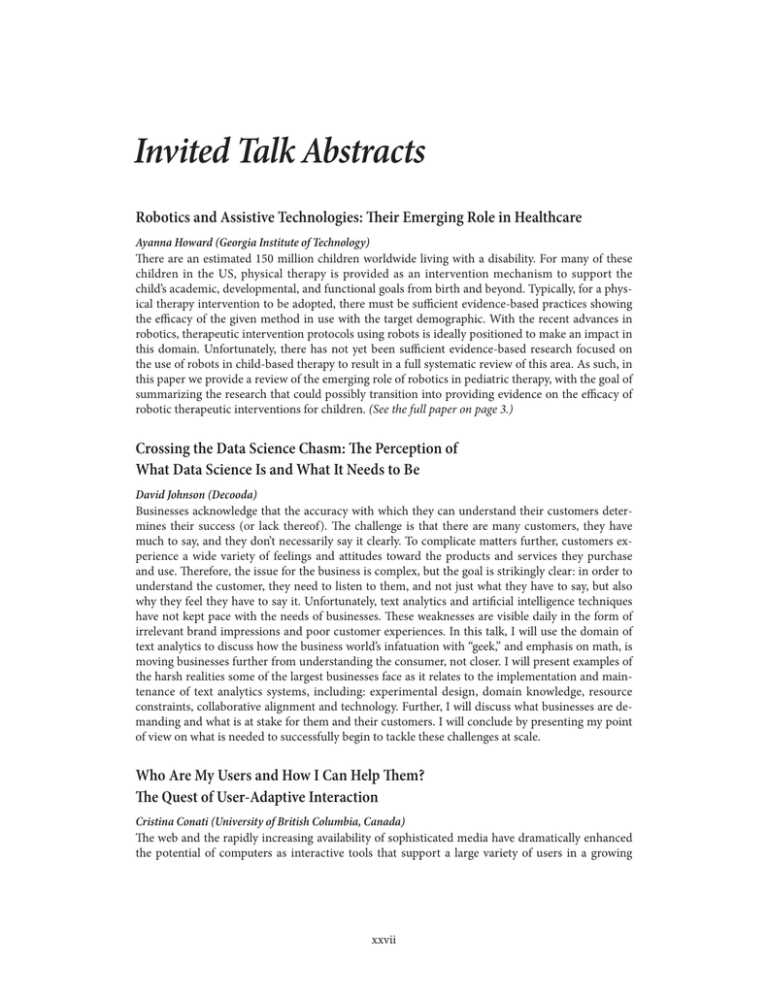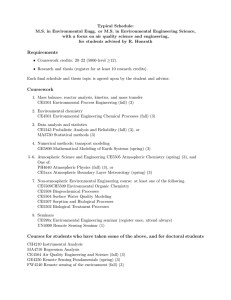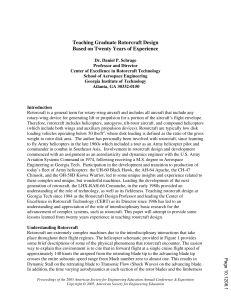Invited Talk Abstracts
advertisement

Invited Talk Abstracts Robotics and Assistive Technologies: Their Emerging Role in Healthcare Ayanna Howard (Georgia Institute of Technology) There are an estimated 150 million children worldwide living with a disability. For many of these children in the US, physical therapy is provided as an intervention mechanism to support the child’s academic, developmental, and functional goals from birth and beyond. Typically, for a physical therapy intervention to be adopted, there must be sufficient evidence-based practices showing the efficacy of the given method in use with the target demographic. With the recent advances in robotics, therapeutic intervention protocols using robots is ideally positioned to make an impact in this domain. Unfortunately, there has not yet been sufficient evidence-based research focused on the use of robots in child-based therapy to result in a full systematic review of this area. As such, in this paper we provide a review of the emerging role of robotics in pediatric therapy, with the goal of summarizing the research that could possibly transition into providing evidence on the efficacy of robotic therapeutic interventions for children. (See the full paper on page 3.) Crossing the Data Science Chasm: The Perception of What Data Science Is and What It Needs to Be David Johnson (Decooda) Businesses acknowledge that the accuracy with which they can understand their customers determines their success (or lack thereof). The challenge is that there are many customers, they have much to say, and they don’t necessarily say it clearly. To complicate matters further, customers experience a wide variety of feelings and attitudes toward the products and services they purchase and use. Therefore, the issue for the business is complex, but the goal is strikingly clear: in order to understand the customer, they need to listen to them, and not just what they have to say, but also why they feel they have to say it. Unfortunately, text analytics and artificial intelligence techniques have not kept pace with the needs of businesses. These weaknesses are visible daily in the form of irrelevant brand impressions and poor customer experiences. In this talk, I will use the domain of text analytics to discuss how the business world’s infatuation with “geek,” and emphasis on math, is moving businesses further from understanding the consumer, not closer. I will present examples of the harsh realities some of the largest businesses face as it relates to the implementation and maintenance of text analytics systems, including: experimental design, domain knowledge, resource constraints, collaborative alignment and technology. Further, I will discuss what businesses are demanding and what is at stake for them and their customers. I will conclude by presenting my point of view on what is needed to successfully begin to tackle these challenges at scale. Who Are My Users and How I Can Help Them? The Quest of User-Adaptive Interaction Cristina Conati (University of British Columbia, Canada) The web and the rapidly increasing availability of sophisticated media have dramatically enhanced the potential of computers as interactive tools that support a large variety of users in a growing xxvii range of tasks. However, designing complex interactive systems that satisfy the needs of individual users from highly heterogeneous user groups is very difficult. This talk focuses on research that aims to overcome this difficulty by investigating how to devise interactive systems that can autonomously, dynamically and unobtrusively adapt to the specific needs of each individual user, namely research in user-adaptive interaction (UAI), a highly interdisciplinary field at the intersection of artificial intelligence (AI), human computer interaction (HCI), and cognitive science. I will present some examples of UAI researcher that we are conducting in our laboratory, including how to devise user-adaptive visualizations, how to provide personalized support to learning from novel educational systems (such as interactive simulations and educational games), and how model relevant user properties in real time by leveraging advanced input sources such as eye-tracking. Industry Talk: Neural Networks in Satellite-Based Atmospheric Remote Sensing Frederick W. Chen (Signal Systems Corporation) Neural networks are useful in satellite-based atmospheric remote sensing because they are capable of learning complicated mathematical relationships and can be used to develop fast algorithms. With neural networks atmospheric remote sensing products can be produced much faster than with algorithms that rely on physics-based inversion methods. This is important for applications where data is perishable (such as nowcasting) and applications involving a large amount of data (such as climate studies). This talk will include descriptions and the results of neural-networkbased algorithms for estimating atmospheric temperature profile and precipitation rate using microwave and infrared data from satellites. An important part of the development of neural-network-based remote sensing algorithms has been the development of preprocessing and postprocessing methods that facilitate neural network learning. Some of these methods include principal component analysis, image sharpening, topological preprocessing, and Stochastic Cloud Clearing. Industry Talk: The Use of Automated Reasoning for Software Verification of Microsoft Products Nikolaj Bjorner (Microsoft Research) Automated reasoning has a long and proud tradition drawing from foundations developed in mathematical logic, inspired by challenges from artificial intelligence and motivated by the use of logic as the calculus of computer science. Software analysis systems use logic as a calculus, as they invariably contain a component using logical formulas for describing states and transformations between system states. Automated reasoning has become an integral part of software engineering tools in recent years, thanks to high-performance theorem provers, in particular, the Z3, satisfiability modulo theories (SMT), solver from Microsoft Research. At Microsoft, the powerful and versatile technology in Z3 has inspired an entire generation of practical tools such as SAGE, PEX, Spec#, Dafny, VCC, Havoc, Boogie, Slam, Yogi, Hyper-V, Spec Explorer, SecGuru, and Terminator. Large portions of the Viridian Hyper-V was formally verified using Z3. The static driver verifier in Windows is used to statically verify absence of certain runtime errors for drivers, it uses Z3. Z3 has been used to solve a few billion constraints produced by SAGE, the world's first white box fuzzer which has found hundreds of previously undetected bugs in Windows and Office. The talk describes background and applications of the Z3 theorem prover in the context of these and other product applications at Microsoft. xxviii Industry Talk: Big Data and Business: Many Needs, Many Domains, Many Opinions, One Destination Charles Wardell (Decooda) Businesses are in a race to establish one-to-one relationships with consumers that are based on more relevant consumer engagements and messaging in order to efficiently drive better bottomline results. The challenge is that consumer communications are fragmented across a wide spectrum of channels: social media, surveys, forums, call centers, texting, focus groups, and others. In parallel, consumer behaviors are also monitored by many client tracking systems as well as by many independent media tracking firms such as Omniture, Google, Webtrends, Nielsen, mobile app providers and many others. To date, the vast majority of organizations have pursued a siloed approach to analyzing big data, with only limited success. The weakness of this approach is visible to all of us in the form of irrelevant brand impressions and poor customer experiences. In this talk, I will address how the renewed emphasis on establishing one-to-one consumer relationships by leading organizations is challenging their departmental teams to address emerging big data issues across many disciplines, including data ingestion, data cleansing, data harmonization and analysis. Further, I will discuss why the big data challenges facing businesses today will only become more complex and onerous as consumer communication channels continue to proliferate and new technologies like Google Glass influence communication behaviors. I will close my presentation by talking about what businesses require in order to lower the barriers to big data success. Industry Talk: Designing Quiet Rotorcraft Approach Trajectories for Next Generation Commercial Airspaces Robert Morris (NASA Ames Research Center) NASA and the international aviation community are investing in the development of a commercial transportation infrastructure that includes the increased use of rotorcraft, specifically helicopters and civil tilt rotors. However, there is significant concern over the impact of noise on the communities surrounding the transportation facilities. One way to address the rotorcraft noise problem is by exploiting search techniques from artificial intelligence to design low-noise flight profiles which can be then validated though field tests. This talk discusses the use of discrete heuristic search methods, as well as recent advances in sampling-based planning in high-dimensional continuous search spaces, to design quiet approach trajectories for rotorcraft. The work builds on a long research tradition in trajectory optimization using either numerical methods or discrete search for space applications. xxix




